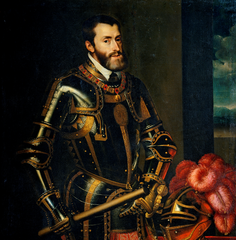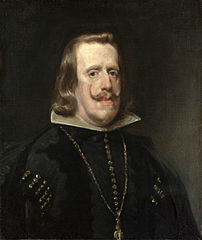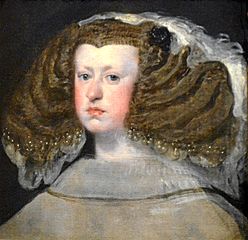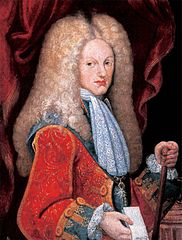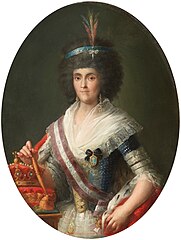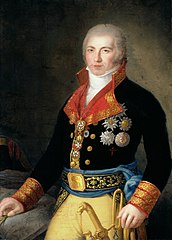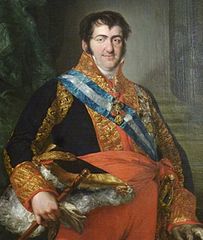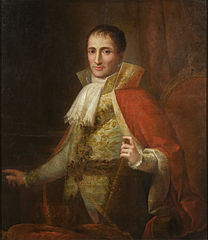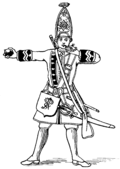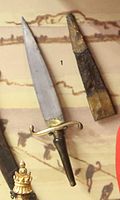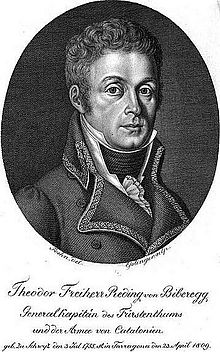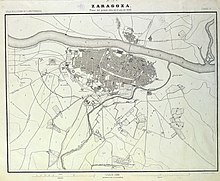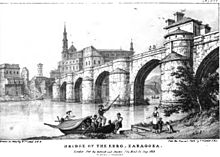Swiss troops in Spanish service
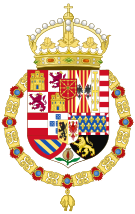
|
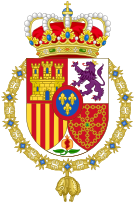
|
|
|
Coat of arms of the
Spanish Habsburgs |
Coat of arms of the
Spanish Bourbons |

Thirty Swiss troops in Spanish service (two of them non-regular units) supported successively two royal dynasties and for a short time a ruler by Napoleon's grace.
From 1574 to 1700 they served the Spanish Habsburgs and from 1700 to 1835 the Spanish Bourbons who succeeded them on the throne of Spain . For a short time, in 1808, two of them were forcibly committed by King Joseph I , who was appointed by his brother, Napoleon Bonaparte .
Swiss troops in foreign service was the name of the paid service of commanded, whole troop bodies abroad, regulated by the authorities of the Swiss Confederation by international treaties .
These treaties contained a chapter regulating military affairs: the so-called surrender (or private surrender if one of the contracting parties was a private military contractor).
Overview of Swiss troops in Spanish service
| for the royal house of the Habsburgs | ||
| # esp | designation | year |
| King Charles V 1516–1556 | ||
| King Philip II 1556–1598 | ||
| 1 | Von Roll Regiment | 1574 |
| King Philip III 1598-1621 | ||
| 2 | Lussy regiment | 1603-1609 |
| 3 | Regiment of Beroldingen | 1610-1637 |
| King Philip IV 1621–1665 | ||
| 4th | Fleckenstein Regiment | 1625-1627 |
| 5 | Zwyer Regiment | 1638-1641 |
| 6th | Crivelli Regiment | 1642 |
| 7th | Lussy regiment | 1642 |
| 8th | Regiment of Beroldingen | 1664-1668 |
| 9 | Cloos regiment | 1664-1668 |
| Queen Maria Anna 1665–1675 | ||
| King Charles II. 1665–1700 | ||
| 10 | Imfeld Regiment | 1673-1679 |
| 11 | Regiment of Beroldingen | 1683-1684 |
| 12 | Buol regiment | 1684-1688 |
| 13 | Meyer Regiment | 1690-1698 |
| 14th | Bessler regiment | 1690-1698 |
| 15th | Capol Regiment | 1693-1706 |
| for the Bourbon royal house | ||
| # esp | designation | year |
| King Philip V 1700–1724 | ||
| 16 | Betschart Regiment | 1703-1706 |
| 17th | Amrhyn Regiment | 1703-1715 |
| 18th | Salis Regiment | 1719-1721 |
| 19th | Mayor Regiment | 1719-1721 |
| King Ludwig I. 1724 | ||
| King Philip V 1724–1746 | ||
| 20th | Niederöst regiment | 1724–1748 then in Naples |
| 21st | Bessler regiment | 1725 |
| 22nd | Arregger Regiment | 1734-1757 |
| 23 |
Sury Regiment 1st Regiment |
1734-1835 |
| 24 |
Regiment Dunant Regiment 2 |
1742–1808 then Napoleon |
| 25th |
Alt-Reding Regiment 3rd Regiment |
1743-1835 |
| 26th |
Jung-Reding Regiment 4th Regiment |
1743-1835 |
| King Ferdinand VI. 1746-1759 | ||
| King Charles III 1759-1788 | ||
| King Charles IV. 1788–1808 | ||
| 27 |
Jann Regiment 5th Regiment |
1793-1810 |
| 28 |
Regiment de Courten 6th Regiment |
1796–1808 then Napoleon |
| 29 |
Stuart regiment not regular |
1798-1818 |
| King Ferdinand VII. 1808–1808 and 1813–1838 | ||
| 30th |
Regiment Suizos de Aragon not regular |
1808-1809 |
| for Napoleon Bonaparte | ||
| # esp | designation | year |
| King Joseph I , 1808–1813 | ||
| 24 |
Regiment Dunant Regiment 2 |
1808 |
| 28 |
Regiment de Courten 6th Regiment |
1808 |
The Spanish multi-ethnic state of the Habsburgs, created through marriage and acquired through marriage
She was eighteen years old and emancipated, Isabella , princess with green, slanted eyes and red hair from the house of Castile-Leon , when she proposed to Ferdinand the Catholic , a year younger candidate for the throne of Aragon , in 1469 and married the man who agreed .
Five years later, Isabella was crowned queen and ruled Castile-Leon with her husband. In 1479 Ferdinand was King of Aragon and the couple ruled together over the separate kingdoms of Castile-Leon and Aragon. This was the nucleus of the future Spain.
In 1492, in the year when the united kingdoms of Castile and Aragon and Granada conquered the last Muslim rule on the Iberian Peninsula and thus ended the Reconquista , Christopher Columbus discovered America under the Spanish-Castilian flag . It was the beginning of the mighty Spanish empire .
When Queen Isabella died in 1504, her only son Johann had been dead for seven years and her daughter Johanna , known as the Mad (Spanish: Juana la Loca ), was her successor over Castile. She was married to Philipp , called the Handsome (Spanish: Felipe el Hermoso ), from the House of Habsburg . He was able to assert himself against Ferdinand, the father-in-law, as co-regent in Castile, but died in 1506.
Ten years later Ferdinand passed away and Johanna was nominally queen of the united kingdoms of Castile and Aragon, which were in fact ruled by ecclesiastical governors , although Ferdinand had been arrested in the royal palace of Tordesillas since 1509 , allegedly because of mental illness. Johanna spent another 40 years under house arrest in Tordesillas after her son Charles was made King of Spain in 1516.
In 1519, on the death of his grandfather, Emperor Maximilian I , Karl inherited the Habsburg ancestral lands and was also elected Roman-German king with a lot of money from the banking house of the Fugger from Augsburg, who in return received considerable economic privileges in the empire . In 1530 he was officially crowned emperor by Pope Clement VII in Bologna as the last Roman ruler .
The Habsburg Charles V had become the ruler of the most powerful multi-ethnic state of all time through his grandfather Maximilian I's marriage policy . In 1580, after the Avis dynasty died out , in personal union with Portugal , the sun should literally never set again!
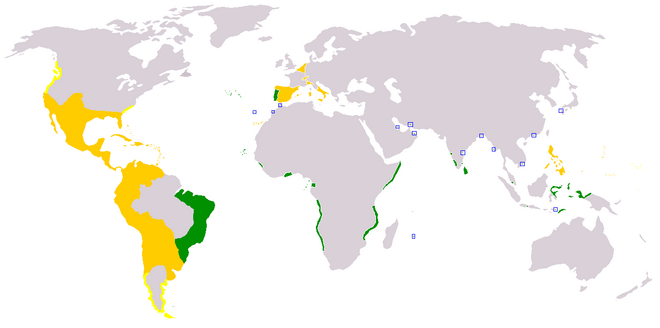
Habsburg's Spanish Challenges: France and the Seven Calvinist Provinces of the Netherlands
With the death of Emperor Maximilian I , his grandson and successor Charles V united for the first time all of the Habsburg territories in one hand. Charles V had inherited a huge empire with Spain, Burgundy, the Netherlands, Sicily, southern Italy, Sardinia and the Spanish colonies overseas. First, France was completely enclosed by Habsburg territory and, secondly, including the overseas territories, its confrontation with Habsburg grew from a European to a global dimension. Charles V's ambitions for a universal monarchy for Europe encountered resistance from France's Francis I and soon the first religious conflicts between Catholics and Protestants.

Dominions of Charles V
Burgundy: Castile Red: possessions Aragon Orange: Burgundian possessions Yellow: Austrian hereditary lands Pale yellow: Holy Roman Empire |
The antagonism between Habsburg and France was to determine, more or less covertly, European politics and its constant wars for the next two centuries. King Franz I alone fought four wars with Emperor Charles V for supremacy in Europe in a good two decades (1521–1544) , both with changing coalitions. The main theaters of war were the Pyrenees, the Meuse, Picardy and mainly Italy.
In Italy in particular , the political equilibrium was in imbalance, and in the north of it the Duchy of Milan changed hands several times before it came under the ownership of Spain in 1545 (confirmed in the Peace of Augsburg in 1555 ), where it remained until the end of the War of the Spanish Succession in 1714.

In the Spanish-Dutch War from 1568 to 1648, the Republic of the United Netherlands won its independence from the Spanish crown. With its end, the northern Netherlands left the association of the Holy Roman Empire of the German Nation . The southern part of the Netherlands, however, remained with Spain; Belgium emerged from this in the 19th century. The Netherlands was thus permanently divided.
The war developed out of an uprising against the Spanish and Catholic sovereign Philip II , which started mainly from Calvinists . After the Spaniards were able to put down the first uprising, unrest developed again from 1572, which gradually spread to the whole country. With the exception of a twelve-year armistice in the period from 1609 to 1621, the fighting continued until 1648. Finally, Spain officially recognized the independence of the northern Netherlands in the Peace of Westphalia in 1648.
In both conflict areas, against France and in the Netherlands, Swiss troops and mercenaries were deployed.
With the possession of the Free County of Burgundy in the west of Switzerland (salt supplier) and the Duchy of Milan in the south (granary and sales market for cattle breeders in Central Switzerland), Spain had become an economically important neighbor of the Swiss Confederation. The Catholic inner cities in particular began to bind themselves to the Spanish Duchy of Milan through friendship and later alliance agreements, from which the two equally Catholic cantons of Freiburg and Solothurn (from 1530 the seat of the French ambassador) stayed away.
In 1515, before the Reformation, the Confederates and Ferdinand, the Catholic - confirmed by Charles V in 1522 - had come closer with an alliance, albeit without consequences, Ferdinand died a year later.
In 1552, Charles V renewed the treaty of Massimiliano Sforza , the last Duke of Milan, of 1512 with the Catholic cantons: the surrender of Milan listed the preservation of the Catholic religion as a purpose, promised considerable pensions to the Catholic towns, allowing them free access to Lombardy and Milan, was supposed to supply Ticino with food of all kinds, allowed the Spanish troops to use the Alpine passes and was renewed regularly. Finally, in 1568, the Catholic towns approved for the first time - despite the federal treaty with France of 1480 - a request for advertising from Spain's King Philip II's envoy, Giovanni d'Anguisciola, which was then not implemented.
But in 1574 Uri, Unterwalden and Zug single-handedly agreed to surrender. Powerful families like von Roll, von Beroldingen, Lussy or Fleckenstein were friendly to Spain, in other words: interested in Spanish pensions.
In 1639 Philip IV of Spain agreed a Milan surrender with the 3 Protestant leagues neighboring Lombardy . However, it was not until 1683 that troops were officially raised.
The Swiss troops raised in Spanish service on the basis of these alliances were deployed in the Spanish Duchy of Milan, in the Spanish-Dutch War, and in the clashes between Habsburg Spain and the kingdoms of Portugal and France.
| Name, duration of use |
(1 esp ) Regiment von Roll | |
| Year, contractual partner |
1574, Philip II surrendered with Uri, Unterwalden and Zug.
Philip II's ambassador to Switzerland, Giovanni d'Anguisciola, had already found a hearing in central Switzerland as early as 1568 when the Free County of Burgundy was threatened with a break-in by the troops of William of Orange . He appealed to the determination of the "faithful uprising" in the inheritance of the Confederates with the Habsburgs in 1511. The attack did not materialize, however, and so did the troops. The French ambassador, Pomponne de Bellièvre, fearing the French mercenary monopoly, had worked against it violently. Six years later, the focus was on the Netherlands. The Spanish governor there, the Duke of Alba, Fernando Álvarez de Toledo , had failed, and had even driven Spanish finances into bankruptcy. He was therefore replaced in 1573 by Don Luis de Zúñiga y Requesens , who needed troops but could not pay them. The Spanish troops therefore marched through the country, pillaging, pillaging and raping. Antwerp was asked to pay 500,000 guilders in order to avert further looting, which it had to settle due to a lack of liquidity in materials (especially silk fabrics). After initial successes, Zuniga was ultimately unable to master the situation and passed away in 1576. For him, Philip II sent Pompeio della Croce to the Confederates as an ambassador for troop reinforcements in 1574. Not familiar with their customs, he referred to the unused request of his predecessor and demanded 4,500 men in 15 pennants, but not in a daily statute. Instead, he approached the cantons individually, starting in Uri, where he had set up his residence. He also ignored the suburb of Lucerne, which reacted offended. Schultheiss Ludwig Pfyffer pointed out the considerable debts of the Spanish king and ensured that other places followed suit and banned advertising. Freiburg and Solothurn (French ambassador city), both under strong French influence, clearly refused. The ambassador of France, Jean de Bellièvre, Seigneur de Hautefort, pulls all (financial) levers in motion. Schwyz and finally even Zug issued advertising bans. Nevertheless, Spain found a positive echo in Uri and Unterwalden and Colonel von Roll brought together his 4,500 men in the country towns with Spanish money. |
|
| Stock, formation |
1 regiment of 4,000 men in 10 flags of 400 men. | |
| Origin squad, troop |
Catholic Central Switzerland. | |
| Owner, commander, namesake |
Colonel Walter von Roll from Uri. | |
| Use, events |
In the meantime, Prince William of Orange, converted to Calvinism, had taken over the leadership of the renegade Geusen and brought all of Zeeland under control. Von Roll moved to the Netherlands in May 1574, but was not in use for long. He seems to have fallen out with Zuniga. When the Geusen pierced the dykes in Leiden (in South Holland, northeast of The Hague) in autumn and flooded the surrounding polders , the Spanish troops had to withdraw. Von Roll was released and returned home in September without suffering any significant losses, presumably unpaid ... but no available source provides information about this. However, not without causing aftereffects: Bern and Zurich expressed the greatest displeasure with the train against their fellow believers, Lucerne's displeasure was great and also the discord among the Catholic towns unmistakable about the unauthorized action of Uri and Unterwalden. The next assembly decided that recruitment would in future only be permitted with the joint approval of all locations. Uri, Schwyz and Unterwalden, however, refused to approve the decision, which threatened every envoy - with the exception of the French one - who did secret advertising, arrest and punishment in body and property. Spain had established itself there. |
|
| Name, duration of use |
(2 esp ) Lussy Regiment 1603–1604 and 1607–1609 | |
| Year, contractual partner |
1600 and 1607, surrenders of Unterwalden with Philip III. | |
| Stock, formation |
1 regiment of 3,000 men, consisting of 9 flags of 290 men and a special flag of 390 men. | |
| Origin squad, troop |
From Catholic Central Switzerland. | |
| Owner, commander, namesake |
Colonel Kaspar Lussy from Unterwalden.
At the beginning of the 17th century the colonel had no staff as the commander, he carried his own flag (la Colonella) and was deputy captain of the largest unit, the special flag, who assumed command in his absence or death. The functions of those responsible for the riflemen, halberdiers, pikemen, guards, justice and the baggage train were divided among the other captains. They were determined by the calling cantons, while the colonel was determined by the king. |
|
| Use, events |
In 1601 the Spanish troops began the extremely loss-making siege of Ostend , which was still the only position of the rebels in Flanders . In 1603 the situation got bogged down and Spain, with new troops, including the Lussy regiment, under Ambrosio Spinola, made a new attempt to slowly work its way towards the north-western part of Ostend by building field fortifications . In 1604 Spinola successfully ended the siege of Ostend. The Lussy regiment returned home severely decimated in 1604. But the fighting continued. In 1607 Lussy again moved to the Netherlands with a regiment and suffered considerable losses. After the heavy defeat of the Spanish Armada against the Dutch fleet off Gibraltar in 1607, Spain sought an armistice that was agreed in 1609 and lasted until 1621. The Lussy regiment was abdicated in 1609. |
|
| Name, duration of use |
(3 esp ) Regiment von Beroldingen 1610, 1613, 1614, 1616, 1620, 1625–1627 and 1635–1637 | |
| Year, contractual partner |
1610, Uri with Philip III. | |
| Stock, formation |
1 regiment of 4,000 men, consisting of 9 flags of 390 men and a special flag of 490 men. | |
| Origin squad, troop |
Mostly from Catholic Central Switzerland, excluding Lucerne (only took part in Spanish service in 1664: Cloos regiment ). | |
| Owner, commander, namesake |
Konrad von Beroldingen from Uri.
From 1625 the colonel had a kind of simple staff, consisting of a judge, Profoss, Feldweibel and Fourier, but no lieutenant colonel. |
|
| Use, events |
The regiment was deployed in the Duchy of Milan, ruled by Spanish governors, abdicated six times at the end of the year and reassigned seven times.
The tasks are likely to have been garrison and security service in Milan and other important cities of the duchy. |
|
| Name, duration of use |
(4 esp ) Fleckenstein Regiment 1625–1627 | |
| Year, contractual partner |
1625, Lucerne with Philip IV. | |
| Stock, formation |
1 regiment of 3,000 men with 8 companies of 320 men and an elite company of 440 men. | |
| Origin squad, troop |
From the Catholic Confederation. | |
| Owner, commander, namesake |
Colonel Heinrich Fleckenstein from Lucerne. | |
| Use, events |
The regiment was deployed in the Duchy of Milan, ruled by Spanish governors, and abdicated in 1627. His duties are likely to have been garrison and security service in Milan and other strategically important locations in the duchy. | |
| Name, duration of use |
(5 esp ) Zwyer Regiment 1638–1641 | |
| Year, contractual partner |
1638, Uri with Philip IV. | |
| Stock, formation |
1 regiment of 3,000 men in 4 battalions with 3 companies of 250 men.
Zwyer had as major general and member of the highest war council of Ferdinand III. In 1636 the army reform according to the Swedish system was introduced by King Gustav Adolf in the Habsburg army. His regiment therefore had a lieutenant colonel and a major chosen by the colonel. Each company had one captain (with 4 satellites), first lieutenant, second lieutenant, ensign, field women, fourier, profoss, one sergeant and one corporal for every 50 men (including a standard bearer), 3 tambours, a piper and 234 men. In terms of arming, the musket had replaced the hook-box and the halberd or partisan had replaced the two-handed sword. The companies were divided into musketeers, halberdiers and pikemen and fought without helmets, armor or other defensive armament as too obstructive in battle. The elite company, one per regiment, was chosen from among the musketeers. |
|
| Origin squad, troop |
From the Catholic Confederation. | |
| Owner, commander, namesake |
Sebastian Peregrin Zwyer von Evibach, a Uri, Colonel General from the Austrian service. | |
| Use, events |
The Zwyer regiment served in the Duchy of Milan.
However, difficulties arose because the Spanish governor in Milan wanted to deploy the regiment outside the agreed operational area and the pay failed to materialize, which almost ruined Zwyer. In 1669, eight years after Zwyer's death, his son-in-law, Karl Konrad von Beroldingen, had to deal with Madrid for payments from Milan to settle this debt. |
|
| Name, duration of use |
(6 esp ) Crivelli Regiment 1642–1648 (7 esp ) Lussy Regiment 1642–1648 |
|
| Year, contractual partner |
1642, Uri or Unterwalden with Philip IV. | |
| Stock, formation |
1 regiment of 3,000 men each, organized like the Zwyer regiment . | |
| Origin squad, troop |
From the Catholic Confederation. | |
| Owner, commander, namesake |
Sebastian Heinrich Crivelli, farmer of Uri, promoted to colonel in 1646.
Melchior Lussy from Unterwalden. |
|
| Use, events |
The Crivelli and Lussy regiments served in the Duchy of Milan and were abdicated after the Treaty of Munster , as part of the Westphalian Peace Congress , which ended the Thirty Years 'War and the Netherlands ' eighty years of independence . | |
| Name, duration of use |
(8 esp ) Regiment von Beroldingen 1664–1668 (9 esp ) Regiment Cloos 1664–1668 |
|
| Year, contractual partner |
1664, Uri or Lucerne with Philip IV. | |
| Stock, formation |
1 regiment of 3,000 men each, organized like the Zwyer regiment . | |
| Origin squad, troop |
From the Catholic Confederation. | |
| Owner, commander, namesake |
Johann Josef von Beroldingen from Uri.
Karl Hieronimus Cloos from Lucerne. |
|
| Use, events |
The regiments were first used in the defense of Milan and then shipped to Barcelona in Genoa to be used in the war against Portugal.
The regiments were used in the final phase of the Portuguese War of Liberation , which began in 1640 with the uprising led by John of Braganza . The Portuguese army, with French and English support, was already at an advantage when the battle of Montes Claros broke out in 1665, in which Spain suffered a heavy defeat. Shortly afterwards Philip IV died and the 5-year-old Charles II, his son and successor, was represented by his mother Maria Anna of Austria . She had other problems to solve and stopped fighting in Portugal. In 1668 the war ended with the Treaty of Lisbon . Portugal was finally separated from Spain again. The two regiments returned to Switzerland in 1668, their holdings reduced to less than a quarter. In addition to the fighting, the dysentery and yellow fever had raged among the troops. |
|
| Name, duration of use |
(10 esp ) Imfeld Regiment 1673–1679 | |
| Year, contractual partner |
1673, Unterwalden with Karl II. | |
| Stock, formation |
1 regiment of 3,000 men, organized like the Zwyer regiment . | |
| Origin squad, troop |
From the Catholic Confederation. | |
| Owner, commander, namesake |
Johann Peter Imfeld from Obwalden, previously lieutenant colonel in the Beroldingen regiment, promoted to brigadier in 1675. | |
| Use, events |

Partition of Catalonia in 1659
The regiment was embarked in Genoa for Barcelona and was deployed in Catalonia. Unlike Portugal in 1640, Catalonia failed to break away from Spain during the Franco-Spanish War . In the Peace of the Pyrenees of 1659, however, Spain had to cede the part north of the Pyrenees to France. The southern part had to be secured by order troops. With the peace of Nijmegen in 1679 and u. a. the peace agreement between France and Spain eased the situation to such an extent that Spain was able to reduce its troops in Catalonia. The Imfeld regiment was abdicated in 1679. |
|
A "Blitzkrieg" and inbreeding give Habsburg the rest
A "Blitzkrieg", the Reunionskrieg (1683–1684), was the most successful and shortest war of France Louis XIV against the Netherlands (and indirectly also the Holy Roman Empire ), supported by Spain, which enabled him to conquer Luxembourg and all acquisitions during the Regensburg standstill of the last decades.
After its outbreak, Swiss regiments were again raised for Spain.
| Name, duration of use |
(11 esp ) Regiment von Beroldingen 1683–1684 | |
| Year, contractual partner |
1683, Uri with Karl II. | |
| Stock, formation |
1 regiment of 2,400 men in 3 battalions of 800 men with 4 companies of 200 men.
It was the first Swiss regiment in Spanish service to select a separate company of grenadiers from the musketeers . In the order of battle, the center consisted of musketeers and halberdiers and the wings of grenadiers and pikemen. In 1685 the Musketeers were also equipped for the first time with the bayonet introduced by Jean Martinet in the French army in 1650 . |
|
| Origin squad, troop |
From the Catholic Confederation. | |
| Owner, commander, namesake |
Colonel Karl Konrad von Beroldingen from Uri. | |
| Use, events |
The regiment was shipped from Genoa to Spain and fought against France in Catalonia.
It was part of the Spanish forces of Duke Bournonville , who retreated in 1684 in the meeting near the Catalan town of Pontmajor before the French Marshal Bellefonds. After the siege of Girona was called off, it was put on its rearguard. The Regensburg standstill ended the campaign and service of the von Beroldingen regiment in 1684. |
|
| Name, duration of use |
(12 esp ) Buol regiment 1684–1688 | |
| Year, contractual partner |
1684, three leagues with Charles II.
In 1638 King Philip IV's special envoy, Diego de Saavedra Fajardo, reached an alliance with the Three Leagues, which in 1639, solemnly and with great pomp in the Cathedral of Milan, was followed by a surrender. The alliance ended the Bündner turmoil (Romansh: "Scumbigls grischuns") and, as in the Catholic cantons, was concluded for the life of the king, that of his successor plus five years. In 1723 it served as a template for the Graubünden contract with Charles VI. But it was not until 1684 that an official Graubünden troop set out for Spanish service for the first time. |
|
| Stock, formation |
1 regiment of 2,400 men organized and equipped like the von Beroldingen regiment . | |
| Origin squad, troop |
from the three leagues , laboriously excavated in competition with the stuppas and by Salis for French services. | |
| Owner, commander, namesake |
Paul von Buol-Strassberg from Chur. | |
| Use, events |
The regiment was released after four years of service in the Duchy of Milan. | |
| Name, duration of use |
(13 esp ) Meyer Regiment 1690–1698 (14 esp ) Bessler Regiment 1690–1698 |
|
| Year, contractual partner |
1690, Lucerne and Uri with Karl II. | |
| Stock, formation |
1 regiment of 2,400 men each organized and equipped like the von Beroldingen regiment . The companies, with the cadre like the Zwyer regiment , also received a lieutenant captain. | |
| Origin squad, troop |
From Catholic Central Switzerland. | |
| Owner, commander, namesake |
Kaspar Meyer von Baldegg from Lucerne and Johann Karl Bessler von Wattingen from Uri. | |
| Use, events |
The regiments Meyer and Bessler were shipped from Genoa to Spain and fought against France in Catalonia.
They were used against their campaign as part of the Palatine War of Succession and were abdicated in 1698, the year after the Peace of Rijswijk . |
|
| Name, duration of use |
(15 esp ) Capol Regiment 1693–1706 | |
| Year, contractual partner |
1693, three leagues with Charles II. | |
| Stock, formation |
1 regiment of 2,400 men organized and equipped like the Bessler regiment . | |
| Origin squad, troop |
From the three frets. | |
| Owner, commander, namesake |
Herkules Capol from Flims (joined Dutch service in 1695 with the consent of Charles II), 1695 Jakob Ulrich von Albertini from La Punt-Chamues-ch and Luzein. | |
| Use, events |
The Capol regiment was in action in the Duchy of Milan.
Albertini's regiment remained in Italy and, as part of the Spanish-French army in the War of the Spanish Succession , had more than three quarters of its own when it abdicated in 1706 after the heavy siege of Turin , which was defended by Prince Eugene with Piedmontese and Austrian forces Forfeited. |
|
In the War of the Spanish Succession (1701–1714) after the death in 1700 of the childless last Spanish Habsburg, King Charles II of Spain, the Austro-Habsburg Emperor Leopold I fought together with the Hague Great Alliance from the Holy Roman Empire, England and Great Britain and the Netherlands against the claims of France's Louis XIV and his allies Electorate of Cologne, Savoy and the Electorate of Bavaria for his inheritance.
The main acts of war took place simultaneously in the south of the Holy Roman Empire, in Flanders and Brabant, in northern Italy, in Spain and in the North American colonies. Ultimately, France succeeded in enforcing Philip V as King of Spain. This established the reigning dynasty of the Bourbons in Spain.
The Bourbons replace the Habsburgs
The reign of the last childless Spanish Habsburg Charles II from 1665–1700 had been marked by the plague and decline. Due to lack of money, all Swiss regiments were dismissed at the end of the 17th century. The payments had largely failed to materialize, the debt of the Central Swiss grew more and more. But the free trade with Milan obviously made up for this: the capitulation was finally suspended on the death of Charles II and only put into effect again in favor of the Bourbon successor Philip V as King of Spain when France took over the debts of Spain and the Pay guaranteed for the Bourbon service. It was formally renewed again in 1706, this time for an indefinite period. She first performed the grenadier company and introduced the sky-blue uniform ("the blue Swiss", Spanish: los Suizos azzurros ).
| Name, duration of use |
(16 esp ) Betschart Regiment 1703–1706 | |
| Year, contractual partner |
1703, Schwyz and Uri with Philipp V. | |
| Stock, formation |
1 regiment of 3,200 men in 4 battalions of 800 men with 4 companies of 200 men.
The regiment had a full staff, but had no pikemen and halberdiers. In their place each battalion was assigned a grenadier company of 64 men, including the cadre. It was led by a captain, along with a lieutenant and a sub-lieutenant. |
|
| Origin squad, troop |
From the Catholic Confederation. | |
| Owner, commander, namesake |
Half excavated by Colonel Johann Dominik Betschart from Schwyz and Lieutenant Colonel Josef Anton Püntener from Uri.
Betschart resigned in 1704 because of a wound he had sustained during the siege of Ivrea and passed the command to his lieutenant colonel Püntener. |
|
| Use, events |
When the Duke of Savoy, Viktor Amadeus II , switched to the opposing side, to the Great Alliance , in the War of the Spanish Succession in 1703 , General Feuillade from France and Marshal Vendome from the Duchy of Milan moved into Piedmont with strong troops. The battle raged over the Piedmontese cities and was decided in Turin in 1706 . The capital of Piedmont was successfully defended by the cousin Viktor Amadeus, Prinz Eugen . The French army suffered such high losses that France had to evacuate Lombardy. The Betschart Regiment, together with the Amrhyn Regiment (hereinafter), were incorporated under the Duke of Vendome and lost two thirds of their existence. Colonel Betschart was so badly wounded during the siege of Ivrea that he had to say goodbye. The regiment was abdicated under Colonel Püntener in 1706 when Spain vacated the Duchy of Milan, since according to his surrender it could only be used in Italy. |
|
| Name, duration of use |
(17 esp ) Amrhyn Regiment 1703-1715 | |
| Year, contractual partner |
1703, Lucerne with Philipp V. | |
| Stock, formation |
1 regiment of 3,200 men, organized and equipped like the Betschart regiment .
Unlike the Betschart / Püntener regiment, Amrhyn was able to operate in Spain as well as in Italy. |
|
| Origin squad, troop |
From the Catholic Confederation. | |
| Owner, commander, namesake |
Colonel Karl Anton Amrhyn from Lucerne; 1706 Colonel Jost Amrhyn, his cousin, previously lieutenant colonel of the regiment. | |
| Use, events |
In 1706 the regiment fought successfully but with enormous losses under the Duke of Vendome with the Spanish-French troops at Calcinato , with France under Jacques-Léonor Rouxel, comte de Grancey at Castiglione against the imperial troops and particularly violently in Turin under the command of Herzog d'Aubuisson against the united imperial and Piedmontese forces.
Philip V then had to evacuate Lombardy and formed a regiment from the 4 rump battalions of Amrhyn, consisting of two battalions, which Colonel Amrhyn returned to Switzerland, where he resigned. His cousin Jost led the rump regiment back to France that same year, where it spent the winter in the ranks of General Medavi in Montpellier and was the first Swiss troop in Spanish service to be dressed in the sky-blue uniform. In 1707 it distinguished itself in Spain under the Duke of Berwick at Almanza in Castile and in 1714 during the successful siege of Barcelona in Catalonia. It was abdicated in 1716 after the complete subjugation of Catalonia by France. |
|
Despite successful warfare, Austria's general Prince Eugene was unable to prevent the Bourbons from taking over the Spanish crown, but in the Peace of Rastatt in 1714 he managed to allocate Spanish territories to Austria:
- Breisach on the Rhine ;
- Freiburg im Breisgau and Kehl ;
- the Spanish Netherlands ;
- the Kingdom of Sardinia ;
- the parts of Italy that formerly belonged to the Spanish crown, including Lombardy with the Duchy of Milan and the Duchy of Mantua ;
- and the Kingdom of Naples .
This made the Milan surrender obsolete. The two regiments, Püntener and Amrhyn, were withdrawn from Milan and Swiss regiments in Spain were directly recruited as a result.
| Name, duration of use |
(18 esp ) Regiment of Salis 1719–1721 | |
| Year, contractual partner |
1719, Andreas von Salis with Don Felix Corneyo, ambassador to the Swiss Confederation, for Philip V. | |
| Stock, formation |
1 regiment of 1,600 men with 8 companies of 200 men in 2 battalions. | |
| Origin squad, troop |
from the three frets. | |
| Owner, commander, namesake |
Colonel Andreas von Salis (Rietberg). | |
| Use, events |
The regiment, together with the Mayor Regiment , supplemented the Spanish corps in Sicily, but was dismissed in 1721 after von Salis had resolutely refused a change of denomination, "since the Spanish people cannot bear heretics in Spanish uniforms". | |
| Name, duration of use |
(19 esp ) Regiment Mayor 1719–1721 | |
| Year, contractual partner |
1719, Benjamin Mayor with Cardinal Aquaviva , Ambassador of Spain in Rome, for Philip V, without permission from the Catholic cantons and against the express objection of Bern. | |
| Stock, formation |
1 regiment of 1,600 men with 8 companies of 200 men in 2 battalions. | |
| Origin squad, troop |
From the two regiments released by Venice, Müller and Stockar . | |
| Owner, commander, namesake |
Colonel Benjamin Mayor from Morges died while the troops were in Livorno; 1719, the regiment was taken over by his brother François-Louis Mayor. | |
| Use, events |
The regiment supplemented the Spanish corps in Sicily, but was dismissed by the bigoted king for reasons of faith in 1721, like the regiment of Salis , after Mayor had decidedly refused to change religion. | |
| Name, duration of use |
(20 esp ) Regiment Nideröst 1724–1748, afterwards in Naples until 1789 | |
| Year, contractual partner |
1721, the Catholic cantons and the prince abbot of St. Gallen concluded an alliance with Philip V, which was extended by 20 years in 1744. This was despite the fact that Spain was financially ruined after the War of the Spanish Succession and the Duchy of Milan, traditionally the advertising site of the federal mercenaries, had lost with the Milanese surrender .
For the first time, the king demanded what had previously been reserved for the cantons, namely to appoint the colonel, lieutenant colonel and major! All troops had to profess the apostolic Roman Catholic religion. 1724, Ignaz von Nideröst surrendered for 10 years, renewed in 1734. The troops should be expressly approved as a Schwyz professional regiment and the companies became hereditary. In 1735 Nideröst's successor, Josef Ignaz Wirz from Obwalden, therefore sought confirmation in Schwyz, which the regiment claimed for itself, and declared that:
Schwyz got entangled in quarrels with Unterwalden, represented alternately by Obwalden and Nidwalden in the Diet, which made the matter even more difficult. Schwyz was above all concerned about the cantonal ownership structure of the previously mostly Schwyz companies, the economic basis of the local upper class, and initially did not recognize Wirz's surrender, but ultimately tolerated it. |
|
| Stock, formation |
1 line regiment in 2 battalions with 3 infantry companies of 200 men and 1 grenadier company of 110 men, expanded to 3 battalions in 1728, a total of 2,130 men.
In 1732 the troop strength was increased to 2,840 men by a 4th battalion, which remained in Spain in 1733. Relocated to Naples in 1742, this 4th battalion quickly suffered enormous personnel losses and was disbanded the next year due to over-indebtedness. |
|
| Origin squad, troop |
From the Catholic parts of the (Protestant) regiments of Salis and Mayor (dismissed by Philip V in 1721 for reasons of faith) supplemented with recruits from the Catholic cantons and the prince abbey of St. Gallen. | |
| Owner, commander, namesake |
1724 Colonel Karl Ignaz von Niederöst from Schwyz, Lieutenant Colonel from the Mayor Regiment, with a 10-year contract (extended by 10 years in 1734); 1735 Colonel Wolfgang Ignaz Wirz von Rudenz from Obwalden; 1751 Josef Ignaz Wirz, his son. | |
| Use, events |
Niederöst knew how to discipline the troops that had been pushed around and bring them up to a good level in terms of performance.
The regiment was deployed in Africa against the Moors during the conquest of Oran in 1732 . It left Spain with three of its battalions in 1733 and was used by the Infante Don Carlos Sebastián de Borbón y Farnesio with his regiment together with the Bessler regiment in the conquest of his claims on the Italian peninsula and the Kingdom of Naples and Sicily . He was involved in the Battle of Bitonto and died in the siege and storming of the citadel of Syracuse in 1735. Austria protested vigorously but unsuccessfully at a meeting in 1734 about the offensive deployment of the federal troops, which violated the inheritance . In 1735, after Nideröst's death, command of the regiment was taken over by Colonel Wirz. It was used in the battles against Austria in central and northern Italy in 1742 and 1744 to 1746 in the War of the Austrian Succession . Spain entered the war after the conclusion of the Second Family Pact between the Spanish and French Bourbons. When Philip V died in 1746, however, the war situation was unfavorable. In 1748, until then financed by the Spanish king, the regiment changed definitively to the Neapolitan service in the service of Charles VII, King of Naples and Sicily. He undertook the Spanish surrender extended in 1744, which King Ferdinand IV, his younger son and successor, renewed in 1764 and in the 1780s. The Wirz regiment was abdicated in Naples in 1789. |
|
| Name, duration of use |
(21 esp ) Bessler Regiment 1725–1749 | |
| Year, contractual partner |
1721, the Catholic cantons and the prince abbot of St. Gallen concluded an alliance with Philip V, which was extended by 20 years in 1744. This was despite the fact that Spain was financially ruined after the War of the Spanish Succession and the Duchy of Milan, traditionally the advertising site of the federal mercenaries, had lost with the Milanese surrender .
For the first time, the king demanded what had previously been reserved for the cantons, namely to appoint the colonel, lieutenant colonel and major! All troops had to profess the apostolic Roman Catholic religion. 1725, the capitulation of Karl Alfons Bessler von Wattingen from Uri, mediated by Karl Franz Jauch, Lieutenant Colonel of the Nideröst Regiment changed to Bessler, 1737 extended by 12 years. The troops were approved as the Uri civil regiment and the companies hereditary. |
|
| Stock, formation |
1 regiment of 2,400 men with 3 battalions of 3 fusilier companies of 200 men and 1 grenadier company of 100 men, later increased to 4 battalions with a total of 2,854 men. | |
| Origin squad, troop |
From Catholic Central Switzerland. | |
| Owner, commander, namesake |
1725, Colonel Karl Alfons Bessler von Wattingen from Altdorf, Lieutenant Colonel Karl Franz Jauch from Uri, Major Karl Müller from Glarus; 1742, Friedrich Alfons Bessler, his son. | |
| Use, events |
The third and fourth battalions of the regiment left Spain in 1731, led by his lieutenant colonel Karl Franz Jauch (who succeeded Friedrich Alfons Bessler until 1734) to be deployed in Italy.
In 1733, together with the Nideröst regiment, they were at the forefront of the invasion of the peninsula when the Infante Don Carlos Sebastián de Borbón y Farnesio, who later became King Charles III of Spain . , conquered the territories assigned to him in Parma, Piacenza, Tuscany and, in particular, the Kingdom of Naples and Sicily in 1734/35 and proclaimed himself king. For Emperor Charles VI. the loss of that kingdom was a lesser evil than the risk of its Habsburg dynasty becoming extinct. Without any male offspring and anxious to appoint his daughter Maria Theresa as heir to the throne, he tried to win the approval of France for his pragmatic sanction and therefore consented to a secondary education of the Spanish Bourbons in Naples in the Vienna Preliminary Peace in 1735 . Don Carlos was then crowned King of Naples and Sicily in 1735 as Charles VII. The battalions remaining in Spain were deployed in Africa against the Moors during the conquest of Oran in 1732 . In 1741 they were also transferred to Italy under the command of Friedrich Alfons Bessler. Karl Alfons Bessler died in 1742, the year when his son and the regiment, after the conclusion of the Second Family Pact of the Spanish and French Bourbons, were involved in the war of Austrian Succession in the fighting in central and northern Italy against Austria and its allies. In 1743 the regiment (together with the Arregger regiment) belonged to the army of Count von Gages, who claimed victory in the battle of Campo Santo, as, strangely enough, the opposing commander Count von Traun also claimed victory. Due to differences with his superiors, Friedrich Alfons Bessler moved the regiment to winter quarters in 1745 and withdrew himself to Switzerland. All efforts of the Spanish court to return him were unsuccessful. The troops were then led by deputies until the end of the capitulation and their dismissal in 1749. The sources are not clear. You speak of Johann Jakob Kolin or Sebastian Anton Jauch, and even one of Friedrich Alfons Bessler himself. |
|
| Name, duration of use |
(22 esp ) Arregger Regiment 1734–1757 | |
| Year, contractual partner |
1734, particular capitulation of Peter Arregger from Solothurn with Philipp V. | |
| Stock, formation |
1 regiment of 1,600 men in 2 battalions of 4 companies of 200 men each, increased to 2,400 men in 1742 with 4 companies or a 3rd battalion. | |
| Origin squad, troop |
Parts of the Nideröst regiment supplemented with recruits from Catholic Switzerland. | |
| Owner, commander, namesake |
1734–1736 Peter von Arregger; 1738 Johann Viktor Lorenz von Arregger, his younger brother; 1744 Leonz Mauritz Schwaller from Solothurn; 1751 Karl von Reding from Schwyz. | |
| Use, events |
The regiment was shipped from Genoa to Barcelona and, after crossing Spain, from Cádiz to Africa in 1734 to defend Ceuta and Oran .
The younger brother of the Colonel and Lieutenant Colonel of the regiment, Lorenz, was captured by Algerian pirates while crossing the river, enslaved and spent 4 years under the harshest conditions in Algiers until he was able to buy himself out. In 1736, back in Spain, the regiment was deployed as a protective force against Portugal in Extremadura , where Peter Arregger died and was replaced in 1738 by his brother Lorenz, freshly freed. In 1743 the regiment (together with the Bessler regiment) belonged to the army of Count von Gages, who claimed victory in the battle of Campo Santo, as, strangely enough, the opposing commander Count von Traun also claimed victory. After successfully participating in the campaigns of 1743 and 1744, Bessler left the regiment out of annoyance. He was succeeded by Leonz Schwaller, previously a lieutenant colonel. In 1745 the regiment (with the regiments of Thurn and Alt Reding) played a decisive role in the victories of the Duke of Modena in Novi against the Austrian general Ferdinand Ludwig Schulenburg, in Tortona and in the conquest of the Duchy of Parma and Piacenza . It then distinguished itself (together with the Dunant and Jung-Reding regiments) under the Infante Philip in the Battle of Bassignana. In 1749 the 3rd Battalion was disbanded and in 1751 Schwaller died in Fraga ( Aragon ). In 1751, command passed to Karl von Reding from Schwyz. In 1757 the regiment was abdicated. One battalion was added to the Buch regiment and the second was released. |
|
| Name, duration of use |
(23 esp ) Sury Regiment, 1 Regiment 1734–1823 | |
| Year, contractual partner |
1734, particular capitulation of Josef Sury from Solothurn with Philipp V.
The regiment was avowed by Solothurn in 1756 (recognized under international law), although it had become the property of the king. |
|
| Stock, formation |
1 regiment of 1,600 men in 2 battalions of 4 companies of 200 men each, increased to 2,400 men in 1742 with 4 companies or a 3rd battalion.
In the surrender of 1804, the advertising circles and the organization of the regiments were determined: 2 battalions, each with 1 grenadier company and 4 fusilier companies. The grenadier company numbered 112 men, including 1 captain, 1 lieutenant, 1 sub-lieutenant, 2 sergeants, 8 corporals, 2 tambours and 96 grenadiers. The fusilier company consisted of 206 men, including 2 captains, 2 lieutenants, 2 sub-lieutenants, 6 sergeants, 16 corporals, 4 tambours and 174 fusilers. The staff of the 1st battalion should consist of 21 men and that of the 2nd battalion of 16 men, so the target population of the Spanish Swiss regiments 1-6 in 1807, at the beginning of the French invasion of Spain , was 1909 men. One third of the recruits should be from Switzerland and the rest German . Danes, Swedes, Norwegians and finally members of various European countries (even Poland) were then subsumed under Germans. In practice, however, the third clause could only be complied with by officers. |
|
| Origin squad, troop |
From Catholic Switzerland.
With the surrender in 1804, the Wimpfen regiment's advertising circle was expanded to include the cantons of Solothurn, Freiburg and Aargau. |
|
| Owner, commander, namesake |
1734 Colonel Josef Sury de Bussy; 1745 Colonel Felix Hieronymus Buch; 1783 Colonel Amanz Krutter; 1788 Colonel Franz Josef Schwaller; 1802 Colonel Anton Schmid, an Alsatian, naturalized in Rietholz (Solothurn), with Lieutenant Colonel Viktor Wirz from Solothurn and Major Joseph Schmid also from Solothurn; 1803 Colonel Felix Schwaller from Solothurn; 1804 Colonel Ludwig von Wimpfen from Altkirch (Alsace), from 1814 honorary citizen of Solothurn; 1821 Bellenz major (and graduated colonel) Augustin Cusa until the regiment was dissolved in 1835. | |
| Use, events |

Fortress and village of Exilles
In 1743, during the War of the Austrian Succession , the regiment belonged to the army of Marquis de la Mina, which, together with a French army, advanced into Piedmont. Sury then successfully covered the retreat of the Spanish army in the winter quarters in Provence against the Piedmontese forces. In the campaign of 1744, the four Swiss regiments of Sury, Dunant, Alt-Reding and Jung-Reding in the army of the Spanish Infante Philip took part in the loss-making conquest of the Piedmontese fortifications at Villefranche-sur-Mer and the fortress of Mont Alban which the Piedmontese commander, Victor Amédée François Philippe de Savoie, Marquis de Suze, was captured and 90 cannons could be captured. During the subsequent advance into the county of Nice, the Swiss regiments under Prince Conti stood out in the battle of Cuneo against the Sardinian King Karl Emanuel III. in the ultimately unsuccessful siege of this city. In 1745, while advancing through the Pragelato against the fortress of Exilles under the command of the Count of Lautrec, Sury was fatally wounded in an attack on the Piedmontese fortifications near Usseaux . Colonel Hieronimus Buch replaced him. In 1746 the longest and bloodiest battle at Piacenza ended the war in Italy and finally forced the Franco-Spanish alliance to withdraw from the Apennine peninsula. The Swiss regiments involved had lost most of their officers and soldiers. However, the stocks could be supplemented again in the next year. In 1749, after the Treaty of Aachen , which ended the War of the Austrian Succession, Ferdinand VI reorganized . the Spanish armed forces: the 3rd battalion of the regiment was disbanded. In 1757 the companies were also reduced from 200 to 150 men. Colonel Buch was involved in the expedition to Algeria in 1775 and in the siege of Gibraltar (on the cannon rafts and the fleet) in the American War of Independence . In 1781/82 the regiment was part of the Ehrler Brigade (Brigadier Karl Ehrler, Commander of the 3rd Regiment as Chief, Colonel Hieronimus Buch of the 1st Regiment as 2nd Commander), together with the Swiss Regiments Buch, von Thurn, Ehrler (Alt- Reding) and Betschart (Jung-Reding) in the expedition corps of the Duke of Crillon to Menorca to conquer the English fortress of San Felipe at the port entrance of Mahon . In 1793 the regiment (together with the 2nd regiment) brought up the rear when retreating into Catalonia. In 1794 and 1795 the first battalion fought in the army of Catalonia , and in 1795 the second battalion in that of Navarre . During Napoleon's campaign in Spain , the regiment in Tarragona was in garrison , but scattered over Catalonia, and fought, loyal to the Spanish Bourbons, in more than forty-two loss-making battles and the like. a. in the defense of Saragossa and Tarragona as well as the island de las Medas against the French army and Joseph I. In 1808 it was Lieutenant Franz Krutter from Solothurn who led the volunteers from Igualada and Manresa with 24 men in the victorious battles in the Bruch de Igualada. This action was the signal for the uprising of all of Catalonia! The regiment fought as part of the forces of Theodor von Reding , who Francisco Javier Castaños in 1808 as lieutenant general in the Battle of Bailen at the top of the Swiss regiments the political myth broke the invincibility of the French. Later it was with the division volante (combat troops ad hoc ) of Enrique O'Donnell and Pedro Sarsfield on the way back and forth in Catalonia and in the Réduit in the Catalan mountains in Urgel and Berga . At the beginning of the fighting, in 1808, the Wimpfen regiment had a population of 2056 men, including 562 Swiss. In 1810 the regiment had to be reduced to 1 battalion with 6 companies due to its heavy losses with a special orderly. It was cut - cut off from Switzerland, and therefore with a lack of recruiting and only occasionally supplemented by defectors or prisoners - to a mere 152 men by 1812, at the end of the war! In 1810 the regiment was reduced to 1 battalion with 6 companies with a special orderly. When the Bourbons were back at the helm, stocks recovered only hesitantly. During an inspection in Barcelona in 1820, the chronically underpaid regiment Wimpfen still had 3 chiefs, 35 officers and 411 soldiers. The departure of the regiment loyal to the king was degrading. When the decree of the Cortes had already been announced for release in 1923, the cadre had to escort a penal colony to Mallorca in 1822 (together with those of the 4th regiment) and were then sent in garrison on the island of Menorca . However, the Cortes did not ratify the decree. The regiment was discharged in 1835. |
|
A woman prevails
When in 1740 the last Austrian Habsburg, Emperor Karl VI. , died without a male heir, his successor and daughter, Maria Theresa , who was intended according to the pragmatic sanction , had to assert himself against three other applicants for his inheritance. Bavaria ( Wittelsbacher ), Spain ( Bourbon ) and Saxony ( Wettiner ) united in the Treaty of Nymphenburg of 1741, which was also joined by Prussia, France, Sweden, Naples, the Electorate of Palatinate and Electorate of Cologne, demanded Austria (Habsburgs), supported by Great Britain and the Netherlands, issued in the War of the Austrian Succession 1740–1748. It became a global conflict that was not only fought in Europe but also in America and India. In the peace treaty of Aachen in 1748, however, Austria ultimately only had to leave Silesia to Prussia and Maria Theresa had prevailed as heiress.
In 1743 Philip V had the Swiss troops with the following nominal numbers:
| 2 battalions | Bessler | 1,600 men |
| 3 battalions | Surge | 2,400 men |
| 3 battalions | book | 2,400 men |
| 3 battalions | Dunant | 2,400 men |
| 3 battalions | Alt-Reding | 2,400 men |
| 3 battalions | Jung-Reding | 2,400 men |
| 17 battalions in 6 regiments with 68 companies |
Total | 13,600 men |
These Swiss regiments suffered tremendously in the Austrian War of Succession, in which the Spanish Bourbons entered in 1743, after the Second Family Pact with the French Bourbons had been concluded, with the intention of establishing themselves again in Italy - in the numerous battles and through a horrific desertion rate Losses. Many company owners could no longer replenish the stocks and became impoverished.
Solothurn, for example, temporarily had 32 companies in Spain. With the king owing the payments, forty distinguished families were ruined.
Nevertheless, new surrenders were always concluded.
| Name, duration of use |
(24 esp ) Dunant Regiment, Regiment 2 1742–1808 | |
| Year, contractual partner |
1742, particular capitulation of the Vaudois Georges Dunant with Philip V, represented by the Spanish special envoy Don Blasio Jovér d'Alcazar, for 20 years.
Approved in 1758 by Prince Abbot Cölestin Gugger von Staudach of St. Gallen (recognized under international law), who acquired the regiment. |
|
| Stock, formation |
1 regiment with 3 battalions of 800 men in 4 companies of 200 men. From 1804 organized like Regiment 1 , with the advertising circle Lucerne, St. Gallen and Thurgau. | |
| Origin squad, troop |
From the Stiftsland of the Prince Abbot of St. Gallen and Catholic Appenzell. | |
| Owner, commander, namesake |
1742 Colonel Georges Dunant from Nyon; 1773 Colonel Josef Fidel von Thurn from St. Gallen; 1795 Colonel Johann Christoph Rüttimann from Lucerne; 1805 Colonel Karl von Reding von Biberegg from Schwyz, until 1808 (captured at Bailen), with Lieutenant Colonel Joseph Jacquet from Freiburg (died in Bailen in 1806) and Major Beda von Thurn from Schaffhausen. | |
| Use, events |
In the campaign of 1744 in the War of the Austrian Succession , the four Swiss regiments Dunant, von Sury, Alt-Reding and Jung-Reding in the army of the Spanish Infante Philip took part in the loss-making conquest of the Piedmontese fortifications at Villefranche-sur-Mer and the fortress of Mont Alban part in which the Piedmontese commander, Victor Amédée François Philippe de Savoie, Baron von Suze, was captured and 90 cannons could be captured.
During the subsequent advance into the county of Nice, the Swiss regiments under Prince Conti stood out in the battle of Cuneo against the Sardinian King Karl Emanuel III. in the ultimately unsuccessful siege of this city. In 1746 the longest and bloodiest battle at Piacenza ended the war in Italy and finally forced the Franco-Spanish alliance to withdraw from the Apennine peninsula. The Swiss regiments involved had lost most of their officers and soldiers. However, the stocks could be supplemented again in the next year. In 1747 the Dunant, Buch and Jung-Reding regiments belonged to the troop of Marshal von Belle-Isle , who were able to throw the Austro-Piedmontese troops back from Provence to Piedmont and Lombardy. In the same year two battalions of the regiment (with two of the Jung-Reding regiment) reinforced the defenders of Genoa against the Austrian attacks by General Ferdinand Ludwig Schulenburg. In 1749, after the Treaty of Aachen , which ended the War of the Austrian Succession, Ferdinand VI reorganized . the Spanish armed forces: the 3rd battalion of the regiment was disbanded. In 1757 the companies were also reduced from 200 to 150 men.In 1781/82 the regiment was part of the Ehrler Brigade (Brigadier Karl Ehrler, Commander of the 3rd Regiment as Chief, Colonel Hieronimus Buch of the 1st Regiment as 2nd Commander), together with the Swiss Regiments Buch, von Thurn, Ehrler (Alt- Reding) and Betschart (Jung-Reding) in the expedition corps of the Duke of Crillon to Menorca to conquer the English fortress of San Felipe at the port entrance of Mahon . The regiment advanced into Roussillon in 1793 and served the following year (together with the 1st regiment) as rearguard during the retreat in Catalonia. In 1808 when the French marched into Spain, the 2nd regiment Karl von Reding was in Madrid, d. H. in the midst of French troops and guns. Despite the Lucerne government's threat of losing the right of home if the Lucerne cantons did not lay down their arms, Karl von Reding did not dare to oppose the French. He was incorporated into General Dupont's army corps with 1686 men, only 456 of them Swiss, together with the Valais 6th Regiment de Preux, also stationed in Madrid . Both regiments perished in the Battle of Bailén with the Dupont Army Corps after a direct confrontation between the "French" 2nd von Reding regiment and the "Spanish" 3rd Alt-Reding regiment had previously taken place. However, a large part of the members of the 2nd and 6th Regiments von Reding and de Preux, as the commander of the Spanish Swiss Brigade (consisting of the regiments Wimpfen, Alt-Reding and Betschart) and the winner of the battle, General Theodor von Reding , deserted . From their ranks came the foundation of the new Andalusian regiments Baza , Almeria and Santa Fé , which fought with Theodor von Reding in Catalonia. |
|
| Name, duration of use |
(25 esp ) Alt-Reding Regiment, Regiment 3 1743–1808 | |
| Year, contractual partner |
1742, Josef Anton Reding from Schwyz with Philip V, represented by the Spanish special envoy Don Blasio Jovér d'Alcazar, for 20 years.
1756 avouiert from Schwyz (recognized under international law). |
|
| Stock, formation |
1 regiment with a target stock of 3 battalions with 800 men in 4 companies of 200 men.
Organization from 1804 as with Regiment 1 . |
|
| Origin squad, troop |
Schwyz and Catholic Central Switzerland.
From 1804 with Werbekreis Schwyz, Uri, Ticino, Graubünden, Glarus, Appenzell. |
|
| Owner, commander, namesake |
1743 Colonel Josef Karl von Reding from Schwyz; 1763 Colonel Anton von Reding; 1781 Colonel Karl Ehrler; 1788 Colonel Theodor von Reding , later Lieutenant General; 1806 Colonel Nazar Reding, appointed Governor of Mallorca in 1809, with Lieutenant Colonel Chrétien Bagniaud from Valais and Major Jakob Freudiger from Wilstedt in Germany; 1809 Colonel Anton Kaiser; 1815 Lieutenant Colonel Hans Waltispühl; 1827–1835 Colonel Ignaz Ulrich from Steinen (Schwyz). | |
| Use, events |

Jaén with the Santa Catalina Castle Hill (left)
In the campaign of 1744 in the War of the Austrian Succession , the four Swiss regiments Alt-Reding, von Sury, Dunant and Jung-Reding in the army of the Spanish Infante Philip took part in the lossy conquest of the Piedmontese fortifications at Villefranche-sur-Mer and the fortress of Mont Alban part. During the subsequent advance into the county of Nice, the Swiss regiments under Prince Conti stood out in the battle of Cuneo in repelling the attack by the Sardinian King Karl Emanuel III. on the besiegers of the city. The siege was finally started. In 1746 the longest and bloodiest battle at Piacenza ended the war in Italy and finally forced the Franco-Spanish alliance to withdraw from the Apennine peninsula. The Swiss regiments involved had lost most of their officers and soldiers. However, the stocks could be supplemented again in the next year. In 1749, after the Treaty of Aachen , which ended the War of the Austrian Succession, Ferdinand VI reorganized . the Spanish armed forces: the 3rd battalion of the regiment was disbanded. Reding was heavily in debt and because of the lack of payments came into conflict with the representatives of the Spanish crown, which even earned him two months in prison. In 1757 the companies were also reduced from 200 to 150 men. In 1781/82 the regiment was part of the Ehrler Brigade (Brigadier Karl Ehrler, Commander of the 3rd Regiment as Chief, Colonel Hieronimus Buch of the 1st Regiment as 2nd Commander), together with the Swiss Regiments Buch, von Thurn, Ehrler (Alt- Reding) and Betschart (Jung-Reding) in the expedition corps of the Duke of Crillon to Menorca to conquer the English fortress of San Felipe at the port entrance of Mahon . The regiment under Theodor Reding was involved in a mountain war on the upper reaches of the Bidasoa in the western Pyrenees and in 1793 captured the fort of Hendaye on the French-Basque border, which Colonel Reding, wounded three times, brought in the promotion to brigadier. A year later it covered the hasty retreat of the Spanish from the French troops from the Basque Country, from Irún and Tolosa , with heavy losses , which established Reding's reputation as an excellent officer with excellent military skills. Charles IV promoted him to field marshal and gave him command of the 4th Spanish division in the Portuguese campaign of 1800/01. Reding became commander in chief of the province of Alentejo, which he had conquered with her . When el vómíto negro (German: yellow fever ) erupted in 1803, he became a member of the sanitary committee of the city of Málaga , where the regiment was garrisoned. After a short time, as the only member of the committee who was not sick, he and his troops, which were spared, mastered this epidemic brilliantly, a second time in 1804. In 1806, when its commander was appointed governor of Málaga by Charles IV, the regiment of Gibraltar protected an office which he used to the delight of the residents to rehabilitate the city's treasury and urban inadequacies. When in 1807 Napoleon, under the pretext of forcing Portugal under the continental barrier and exploiting the reservations of the Spaniards against this neighbor, quickly invaded the Iberian peninsula with superior military forces, the Spanish War of Independence broke out a year later . On behalf of the Málaga junta , he brought together all available troops, more than 30,000 men, to form the Andalusian army, which was organized into 5 divisions by the junta in Seville. Reding received, as commander of the 1st division with 8,000 men, including the Alt-Reding regiment under the leadership of Nazar Reding, the order of the army of the French general Dupont , which had already crossed the Sierra Morena to the Guadalquivir to Andújar had advanced to cut off the way. After the 3rd regiment Nazar Redings had conquered the city and the castle of Jaén , Theodor Reding succeeded with his and the 3rd division to push Dupont back to Bailén. In the famous battle of Bailén , in which the 3rd Alt-Reding Regiment temporarily faced the 2nd Reding Regiment, which had been forced into French service, he succeeded in defeating Dupont, the first defeat in all of Europe, with the French Armies in general to destroy the aura of invincibility of Napoleon's troops. It earned him the rank of lieutenant general and gave him a lasting reputation as a Savior throughout Spain that continues to this day. The 3rd regiment was then moved to Catalonia by the Central Junta with the troops under the command of Theodor Reding. There, too, Reding became commander in chief of the Catalan army and fought from Tarragona in a tough guerrilla war against the French invaders under General St. Cyr . He died in 1809 of the wounds he suffered in the Battle of Valls . Later, the 3rd regiment (together with the 1st and 4th regiment) with the volante division (combat force ad hoc ) of Enrique O'Donnell and Pedro Sarsfield traveled all over Catalonia and in the Réduit in the Catalan mountains in Urgel and Berga . With a population of 1807 men, 557 of them Swiss, the regiment entered the Spanish Civil War in 1808. Since recruiting was no longer possible during this war, cut off from Switzerland, the regiment had to be reduced to 1 battalion with 6 companies with a special orderly in 1810 because of its great losses, only mitigated by prisoners or occasional defectors. In 1812 France had to evacuate the Iberian Peninsula after the defeats in Salamanca and Vitoria against the English, which after the French campaign against Russia in Spain by the troops of the Duke of Wellington increasingly gained the upper hand. Even under Ferdinand VII, whose payments were chronically absent, the numbers of the 3rd regiment no longer recovered. During an inspection in Mallorca in 1819, where it was now stationed, there were still 2 bosses, 51 officers and 507 soldiers. The Cortes of Cadíz determined his abdication in 1822. Nevertheless, the rump regiment with sack and pack in Tarragona became part of the Spanish line regiment Cantabria No. 24 and, since a revolution had broken out, had to go straight back into the field. His discharge was finally delayed until the end of the surrender from 1804 to 1835. |
|
| Name, duration of use |
(26 esp ) Jung-Reding Regiment, Regiment 4 1743-1808 | |
| Year, contractual partner |
1742, Josef Anton Reding from Schwyz with Philip V, represented by the Spanish special envoy Don Blasio Jovér d'Alcazar, for 20 years. | |
| Stock, formation |
1 regiment with a target stock of 3 battalions with 800 men in 4 companies of 200 men.
Organization from 1804 as with Regiment 1 . |
|
| Origin squad, troop |
Advertising cantons from 1804: Nidwalden and Obwalden, Lucerne, Zug, Aargau, Rheinau. | |
| Owner, commander, namesake |
1743 Karl Josef Reding from Schwyz; 1751 Josef Ulrich Reding from Schwyz; 1758 again Karl Josef Reding; 1761 Ludwig Reding from Schwyz; 1768 Karl Janser; 1769 Franz Thade Betschart from Schwyz; 1797 Josef Dominik Betschart, with Lieutenant Colonel Paul Schwitter and Major Franz Zay, all from Schwyz; 1809 Franz Zay; Commanders deputizing: 1810 Lieutenant Colonel Roman Hediger, 1815 Brigadier Felix Christen from Urseren, 1826–1835 Colonel Roman Hediger, again. | |
| Use, events |

Mont Alban fortress near Villefranche-sur-Mer
In the campaign of 1744 in the War of the Austrian Succession , the four Swiss regiments Jung-Reding, von Sury, Dunant and Alt-Reding in the army of the Spanish Infante Philip took part in the loss-making conquest of the Piedmontese fortifications at Villefranche-sur-Mer and the fortress of Mont Alban part. During the subsequent advance into the county of Nice, the Swiss regiments under Prince Conti stood out in the battle of Cuneo in repelling the attack by the Sardinian King Karl Emanuel III. on the besiegers of the city. The siege was finally started. In 1746 the longest and bloodiest battle at Piacenza ended the war in Italy and finally forced the Franco-Spanish alliance to withdraw from the Apennine peninsula. The Swiss regiments involved had lost most of their officers and soldiers. However, the stocks could be supplemented again in the next year. In 1747 the regiments of Jung-Reding, Dunant and Buch belonged to Marshal von Belle-Isle's troops, who were able to throw the Austro-Piedmontese troops back from Provence to Piedmont and Lombardy. in the same year two battalions of the regiment (with two of the Dunant regiment) reinforced the defenders of Genoa against the Austrian attacks by General Ferdinand Ludwig Schulenburg. In 1749, after the Treaty of Aachen , which ended the War of the Austrian Succession, Ferdinand VI reorganized . the Spanish armed forces: the 3rd battalion of the regiment was disbanded. In 1757 the companies were also reduced from 200 to 150 men. In 1781/82 the regiment was part of the Ehrler Brigade (Brigadier Karl Ehrler, Commander of the 3rd Regiment as Chief, Colonel Hieronimus Buch of the 1st Regiment as 2nd Commander), together with the Swiss Regiments Buch, von Thurn, Ehrler (Alt- Reding) and Betschart (Jung-Reding) in the expedition corps of the Duke of Crillon to Menorca to conquer the English fortress of San Felipe at the port entrance of Mahon . In 1793, during the First Coalition War , Colonel Betschart covered with 100 selected soldiers the escape of the Anglo-Spanish-Neapolitan expeditionary corps from Toulon, successfully but with great losses . (The successful French siege of Toulon in 1793 was the "journeyman's piece" of the young artillery officer Napoleone Buonaparte , which earned him the rank of brigadier general, and in the following year, after recovering from the wound he suffered, the command of the Italian army . It was the starting point of one exceptionally steep career). In 1798, stationed in the Balearic Islands, 2 battalions of the regiment belonged to the crew on Menorca, which surrendered during the English reconquest of the island with the natural harbor of Mahon by the corps of Lieutenant General Stuart , but received free withdrawal. Before that, a number of members of the battalion (also from the battalion of the Jann Regiment) had defected to the enemy. This formed the Stuart regiment . The Spanish War of Independence began with an excess of 2076 men, 585 of them Swiss, and ended with 755 men. It was moved from the Balearic Islands to the mainland and participated in the Battle of Bailén . It also fought afterwards, mostly in battalion strength, for and with Theodor Reding in Catalonia until his death. In the Battle of Valls, for example, it lost 23 dead and 360 prisoners. Later it took part in the defense of Gerona and Tarragona . At times the 4th Regiment (together with the 1st and 3rd Regiment) was also traveling all over Catalonia with the Volante Division (combat force ad hoc ) of Enrique O'Donnell and Pedro Sarsfield and in Urgel in the Réduit in the Catalan mountains and Berga . Finally, after the decision of the Cortes in Cadíz to dissolve it, his cadre (together with those of the 1st regiment) was sent by Ferdinand VII in a rather unprepossessing manner as an escort of a penal colony to Mallorca and then to the island of Menorca in garrison. The discharge finally took place in 1835. |
|
Spain opposes Napoleon and, in vain, its king
The decline of Spain at the end of the 18th century under Minister of State Manuel de Godoy , the favorite of Queen Maria Luisa , who ruled in place of her weak husband Charles IV , and the overthrow of the French Bourbons in the French Revolution 1789–1799 ultimately led to 1807 Napoleon's campaign in Spain . Under the pretext of militarily forcing Portugal under the continental blockade and taking advantage of Spain's resentment against this neighbor, the invasion of the Iberian Peninsula was swift.
Napoleon's proclamation in 1808 by his brother Joseph Bonaparte as King of Spain triggered the Spanish War of Independence 1808–1814, which brought the Bourbons back to the Spanish throne and revived the Constitution of Cadiz .
| Name, duration of use |
(27 esp ) Regiment Jann , Regiment 5 1793-1810 | |
| Year, contractual partner |
1793, Unterwalden with Karl IV. | |
| Stock, formation |
1 regiment with 3 battalions of 800 men in 4 companies of 200 men.
Organization from 1804 as with Regiment 1 . |
|
| Origin squad, troop |
Since 1804: Unterwalden, Lucerne, Rheinau (Zurich). | |
| Owner, commander, namesake |
1793 Colonel Karl Jann from Stans; 1804 Colonel Georg Traxler from Stans, with Lieutenant Colonel Josef Traxler, his brother, and Major Ludwig Christen from Nidwalden; 1808 Colonel Felix Heinrich Christen (captured in Gerona in 1810). | |
| Use, events |
In 1798 a battalion of the regiment, which had recently suppressed a popular uprising in Palma , was moved from Mallorca to Menorca .
In the same year Menorca was recaptured by England, which had the natural harbor of Mahon in its sights as a naval base for its claims to power in the Mediterranean. The battalion of the Jann Regiment was greatly reduced by desertions, surrendered and was taken prisoner, but was granted free withdrawal. The regiment at the time consisted mostly of non-Swiss people, including Hungarian and Polish deserters. A number of 738 members of the battalion (and the 2 battalions of Rüttimann) are said to have defected to the English during the English invasion in 1798. The English formed the Stuart regiment out of these deserters . Colonel Jann himself was therefore arrested in 1799 on suspicion of treason and only released again as innocent with the other officers in 1802. Even in the Spanish War of Independence, the Trachsler regiment was not lucky. From the garrison in Cartagena , the first battalion was transferred to Valencia in 1808 . On the way it got caught in a confusing situation in the marching column of the French General Moncey and was taken prisoner together with Trachsler. A large part of the team escaped at a favorable moment and fought their way back to Cartagena. Trachsler, some officers and 130 men with the regimental flag marched with Moncey to Madrid. 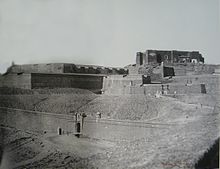
Fortress of Lerida
Trachsler ended up in a specially convened court martial in Valencia for treason. However, this stated that the decision to surrender had been a joint decision of the council of war of all captains. Trachsler continued his career in France, for which sympathies he was apparently known. Finally, both battalions were reunited under Colonel Christians and garrisoned as a regiment in Tortosa , from where it was relocated to Lerida to reinforce the garrison of the fortress. In 1810, after a 32-day siege, Lerida surrendered to the troops of the French general Suchet and the Christen regiment marched into captivity on Autun in France. Some were later released back home on word of honor. Most of the prisoners were not released until 1814. |
|
| Name, duration of use |
(28 esp ) Regiment de Courten , Regiment 6 1796-1808 | |
| Year, contractual partner |
1796, Valais with Charles IV. | |
| Stock, formation |
1 regiment with 2 battalions of 600 men in 4 companies of 150 men.
Organization from 1804 as with Regiment 1 . |
|
| Origin squad, troop |
From the Valais. | |
| Owner, commander, namesake |
1796 Jean-Antoine-Adrièn de Courten from Sierre; 1802 Joseph-Hyacinte-Elle de Courten from Sierre; 1806–1808 Colonel Jean de Preux (captured in Bailén in 1808). | |
| Use, events |
In 1807, during the French invasion of Spain, the 6th Regiment de Preux was in Madrid and got caught up in the French troops. In 1805 the Republic of Valais had concluded a military capitulation with Napoleon, which led de Preux to join France. Like Reding's 2nd Regiment, it was incorporated into General Dupont's army corps .
Both regiments went down in the Battle of Bailén with the Dupont Army Corps and were wiped out. However, a large part of the members of the 6th and 2nd Regiment de Preux and von Reding, to the commandant of the Spanish Swiss Brigade (consisting of the regiments Wimpfen, Alt-Reding and Betschart) and winner of the battle, General Theodor von Reding , deserted . From their ranks came the foundation of the new Andalusian regiments Baza , Almeria and Santa Fé , which fought with Theodor von Reding in Catalonia. The battalion commanded by Charles Louis de Bon of St. Maurice was involved in the defense of Gerona in 1809 . But then it happened - the Valais was annexed by Napoleon as the French department of Simplon in the same year! - transferred to French services, was recalled in 1810 and incorporated into a French regiment the following year. |
|
| Name, duration of use |
(29 esp ) Stuart Regiment , not regular 1798–1818 | |
| Year, contractual partner |
Founded by the British Commander-in-Chief General Charles Stuart in Menorca in 1798, without any influence from the Federal Diet. | |
| Stock, formation |
1 regiment. No information on inventory and organization. | |
| Origin squad, troop |
Deserters from the Swiss regiments Rüttimann and Jann .
Depending on the source, it is said to have been around 300 men, 738 Polish and Hungarian deserters or even 1,000 Germans who were sold as Austrian prisoners from France to Spain for two dollars a head. |
|
| Owner, commander, namesake |
Brigadier General John Stuart of the same name was the commander of the troops under Lieutenant General Charles Stuart , commander of the successful British expeditionary force during the conquest of Menorca in 1798 with the fortress of San Felipe. | |
| Use, events |
When the Spanish troops surrendered in Ciutadella on Menorca , 2 battalions of the Rüttimann regiment and 1 battalion of the Jann regiment also received free withdrawal, but without their deserters.
From these, the troop commander is said to have formed the Stuart Regiment under the British Commander in Chief of the same name . It was then moved to Gibraltar in 1800 as the Minorca Regiment (German: Menorca) and in 1801 to Egypt, where it stood out against Napoleon's cavalry in the Battle of Alexandria under General Abercromby , captured an infantry flag, but left 300 men out of 795 on the battlefield. In 1802, when it was withdrawn from Egypt, it received the name Regiment Queen's Own Germans (German: the Queen's own Germans) as an award . Trained under General Moore in the Shorncliffe Army Camp in the Shorncliffe System in 1803 and became the 95th foot of light infantry (German: light infantry regiment number 95), it fought from 1808 to 1811 as part of the Rifle Brigade (German: rifle brigade) under the Duke of Wellington in the Spanish War of Independence against France in Portugal at the battle of Vimeiro and in Spain at Talavera and Albuera . This British regiment of (at least partially) Swiss origin was disbanded in 1818. |
|
| Name, duration of use |
(30 esp ) Suizos de Aragón regiment , not regular 1808–1809 | |
| Year, contractual partner |
Formed in 1808 by Captain General José de Palafox y Melci without the influence of the Federal Diet. | |
| Stock, formation |
1 regiment with a target population of 800 men in 2 battalions with 4 companies of 100 men. | |
| Origin squad, troop |
Made up of various detachments that had rushed to aid Zaragossa during the first siege in 1808. A larger part came from the 1st Wimpfen regiment. | |
| Owner, commander, namesake |
The commandant was Colonel Stefan Fleury. | |
| Use, events |
In 1808, after 61 days, Palafox and his corps succeeded in forcing the French to break off the first siege of Saragossa .
The Suizos de Aragón regiment with its several hundred men fought in the Palafox army of around 15,000 men in the 3rd division of Brigadier José Manso y Solá on the front line and excelled with determined, fearless actions. 
Second Siege of Saragossa 1809
(Magdalena at the east end and Misericordia at the southwest of the city) There were mainly two Swiss detachments: First, a group of 79 men from the Valais 6th Regiment de Preux, led by Captain Adrian Walker and a lieutenant. They had deserted from the French compulsory division at the Battle of Bailén . They were used to defend the Torre del Arzobispo (German: Tower of the Archbishop) 100 m outside the Arrabal (German: the suburb) on the left side of the Ebro , the northern entrance to the city, which they reached with 84 men and 71 rifles Abortion of the first siege could hold. Second, a larger unit from the 1st Wimpfen Regiment, led by Stefan Fleury, with 361 men from Tarragona , which arrived after the first siege had been broken off. Within a month it had an influx of further Swiss, including foreigners and deserters from French ranks (especially Germans and Poles) and grew to a spectacular 800 men. What prompted Fleury to propose the establishment of a regiment Suizos de Aragón at Palafox according to the surrender of 1804, which the latter approved. At the first inspection by Palafox, Colonel Fleury and his adjutant, Captain Walker, were able to show a staff with an ensign, chaplain and surgeon each, a total of 666 men, 100 of them Spaniards, in 2 battalions of 4 companies each. Again, the main task assigned to him was the Torre del Arzobispo, from which he had to withdraw into the Arrabal because of the violent attack by the French Gazan division , with heavy losses of 300 men and wounded . At the end of the year he still had 496 men with 2 captains, 2 lieutenants, 1 sub-lieutenant, 15 sergeants, 28 corporals and 445 soldiers. For a courageous failure at the head of 269 men, he received a red ribbon on his lapel as an award from Palafox. In January, with Fleury and Walker wounded in the hospital of the San Francisco monastery, a Spanish Colonel Casamayor, who had experience with foreign troops, took over the regimental command, which now occupied the positions Arrabal, Misericordia and Magdalena with 337 men. In mid-February, in the final phase of the fighting, 50 members of the regiment deserted from Arrabal, which was under heavy fire, to the French. These laid the suburb with 56 pieces of artillery of various calibres in rubble and ashes and blew up the San Francicsco monastery before the last big attack before the surrender. The wounded Fleury had survived the explosion in the hospital and held the position there with some loyal followers for two days before falling victim to a French bayonet in close combat. The French conquered the city, captured 18 cannons and 5 standards and took 2,900 prisoners. Zaragoza had capitulated. The regiment disbanded in 1809 after the surrender at the 2nd siege of Saragossa , which left the city heavily destroyed by weeks of artillery fire, with over 50,000 dead and plagued by hunger and typhus. The memory of the deployment of the Swiss soldiers is cherished in Spain: the Asociación Histórico-Cultural Teodoro Reding (!) (German: Kulturhistorische Gesellschaft Theodor Reding) even reports on a reenactment (reenactment) of the sieges of Zaragoza in 2009. |
|
In the Spanish War of Independence, which was waged with extreme cruelty , the Swiss troops in Spanish service, cut off from Switzerland, suffered enormous losses and even got into a fateful direct confrontation in the opposing ranks in Bailen . The troops had to endure unspeakable hardships and were ultimately no longer paid.
Before the Spanish Bourbons could return to an absolutist regime with French help, a decree of the Cortes proclaimed that the Swiss regiments were to be dissolved in 1823. But in 1823 the French invasion ended the burgeoning Spanish revolution . King Ferdinand VII was freed from the hands of the revolutionaries. He did not enforce the promised amnesty , repealed most of the legislative changes in the past three years and ordered unscrupulous reprisals against the revolutionaries. The decree dismissing the Spanish Swiss regiments was never ratified.
The sources provide sparse information about the location and deployment of the Swiss regiments during and after this time.
One speaks of a total of 300 men in all three regiments in 1823, consisting mostly of invalids or old age veterans. In addition, the persistent demarches of those affected and then of the suburbs of the Confederation and later of the Federal Council to collect the wages arrears, which had grown to over 1.2 million francs, had already started the following year. It was not until 1893 that Spain had at least partially paid off this debt.
Another names 1835 as the year of abdication. Another lists the commanders up to 1835. So, at least on paper, the regiments still existed.
In 1828 the French occupation troops had left Spain again and Ferdinand VII ruled for another six years until his death in 1834.
In 1835, a year later, after the surrender of 1804, the history of the Swiss troops in Spanish service was officially and definitively over - with the exception of the outstanding accounts.
bibliography
- Beat Emmanuel May (by Romainmôtier): Histoire Militaire de la Suisse et celle des Suisses dans les differents services de l'Europe. JP Heubach et Comp., Lausanne 1788, OCLC 832583553 .
- Karl Müller von Friedberg : Chronological representation of the federal surrender of troops to foreign powers. Huber and Compagnie, St. Gallen 1793, OCLC 716940663 .
- Albert Maag: History of the Swiss troops in the war of Napoleon I in Spain and Portugal (1807-1814) , first volume, published by Ernst Kuhn, Biel 1892, OCLC 832211483 .
- Heinrich Türler, Viktor Attinger, Marcel Godet: Historisch-Biographisches Lexikon der Schweiz , fourth volume, Neuchâtel 1927, OCLC 899085687 .
- Moritz von Wattenwil: The Swiss in foreign military service. Separately printed from the Berner Tagblatt , Bern 1930, OCLC 72379925 .
- Paul de Vallière, Henry Guisan , Ulrich Wille : Loyalty and honor, history of the Swiss in foreign service (translated by Walter Sandoz). Les éditions d'art ancien, Lausanne 1940, OCLC 610616869 .
- Norbert Furrer, Lucienne Hubler, Marianne Stubenvoll, Danièle Tosato-Rigo: Gente Ferocissima, Sold Service and Society in Switzerland (15th to 19th Century) , Festschrift for Alain Dubois, Chronos Verlag, Zurich 1997, OCLC 243859770 .
- Robert-Peter Eyer: The Swiss regiments in Naples in the 18th century (1734–1789) , Freiburg studies for the early modern period, Peter Lang AG, Internationaler Verlag der Wissenschaften, Bern 2008, OCLC 758759765 .
See also
Web links
- War of the Austrian Succession (Youtube Video)
- Cultural-Historical Society Theodor Reding (Spanish)
Individual evidence
-
↑ Karl had the official title:
(with etc. all titles of a minor degree were subsumed)" We, Charles the Fifth, Roman Emperor chosen by God's grace, at all times multiples of the empire, in Germania, in Castile, Aragon, León, both Sicilies, Jerusalem, Hungary, Dalmatia, Croatia, Navarra, Granada, Toledo, Valencia, Galicia, Mallorca, Seville, Sardinia, Córdoba, Corsica, Murcia, Jaén, Algarve, Algeciras, Gibraltar, the Canary and Indian Islands and the mainland, the Oceanic Sea & c. King, Archduke of Austria, Duke of Burgundy, Lorraine, Brabant, Steyr, Carinthia, Carniola, Limburg, Luxembourg, Geldern, Calabria, Athens, Neopatria and Württemberg & c. Count of Habsburg, Flanders, Tyrol, Gorizia, Barcelona, Artois and Burgundy & c. Count Palatine at Hainaut, Holland, Zealand, Pfirt, Kyburg, Namur, Roussillon, Cerdagne and Zutphen & c. Landgrave in Alsace, Margrave of Burgau, Oristan, Goziani and the Holy Roman Empire, Prince of Swabia, Catalonia, Asturias & c. Lord of Friesland and the Windische Mark, Pordenone, Biscaya, Monia, Salins, Tripoli and Mechelen etc. "
-
↑ a b c d e Renewal of the Milan surrender , in each case for the duration of the reign of the king, his successor plus 5 years, from 1706 for an indefinite period:
year king Representative Confederates Place / special 1552 Charles V Governor of Milan, Ferrante I. Gonzaga , Principe di Molfetta, Duca di Ariano Lucerne, Uri, Schwyz, Unterwalden, Catholic Glarus and Prince Abbot of St. Gallen Milano 1588 Philip II Governor of Milan, Carlo de Aragona, Duke of Terranuova , Prince of Castelvetrona Lucerne, Uri, Schwyz, Unterwalden, Zug and Freiburg (as well as from 1596 also Catholic Appenzell) Milano 1604 Philip III Envoy to the Confederates, Conte Alfonso Casati (father) Lucerne, Uri, Schwyz, Unterwalden, Zug, Freiburg and Catholic Appenzell Lucerne 1634 Philip IV Envoy to the Confederates, Conte Gerolamo Casati (son) Lucerne, Uri, Schwyz, Zug, Unterwalden, Freiburg, Catholic Appenzell and Prince Abbot of St. Gallen Lucerne 1706 Philip V. Envoy to the Confederates, Marchese Don Verezuso Beretti-Landi Lucerne, Uri, Schwyz and Unterwalden, the other Catholic cantons followed in 1708 and 1710 Lucerne 1804 Charles IV Envoy to the Confederates, caballero Pardo Juan José de Caamaño Diet of the Confederation and the Republic of Valais Bern and Sitten.
65 paragraphs (without additional articles).
Established advertising cantons per regiment. - ^ Moritz von Wattenwil, The Swiss in foreign war services , separate print from the "Berner Tagblatt", Bern 1930.
- ^ Paul de Vallière, Henry Guisan, Ulrich Wille: Loyalty and honor, history of the Swiss in foreign service . (Translated by Walter Sandoz). Les editions d'art ancien, Lausanne 1940.
- ↑ a b c d e f g h i j k l m Heinrich Türler, Viktor Attinger, Marcel Godet, Historisch-Biographisches Lexikon der Schweiz , fourth volume, Neuchâtel 1927.
- ↑ a b Erich Meyer: Spanish advertising requests and the controversies between cities and countries , yearbook for Solothurn history, volume 40, published by the historical association of the canton of Solothurn, Buchdruckerei Gassmann AG, Solothurn 1967.
- ↑ When they were inherited from the House of Austria (1511), the towns had undertaken to "keep a faithful stir" on their possessions, especially the Free County of Burgundy. Even after they passed to Spain, this promise remained in force. Whether the faithful attention also included military aid if necessary remained controversial. That was the view in Dole; the Confederates, on the other hand, did not want anything other than oral or written advocacy in favor of the threatened neighbors. The reason for this was the consideration that one had to take on France.
- ^ Connection of the Confederation with France through the Eternal Peace (1516) and the Alliance (1521).
- ^ André Holenstein: Eternal Peace. In: Historical Lexicon of Switzerland .
- ↑ The annual French state pensions fed the coffers of the towns and the particular pensions as well as secret subsidies to important exponents of the old Confederation had an effect.
- ↑ Urs Kälin: Roll, Walter (from). In: Historical Lexicon of Switzerland .
- ^ A b Hans Wieland: Swiss troops in foreign service IV. , General Swiss military magazine, No. 17, Basel 1855.
- ↑ a b c d e f g h i j k l m n o p q r s t u v w x y z aa Beat Emmanuel May (from Romainmôtier): Histoire Militaire de la Suisse et celle des Suisses dans les differents services de l'Europe. Tome I et VII, JP Heubach et Comp., Lausanne 1788.
- ↑ Fabian Hodel: Lussi, Kaspar. In: Historical Lexicon of Switzerland .
- ↑ Hans Jakob Leu: General Helvetisches / Eidgenössisches / oder Schweizerisches Lexikon ..., Volume 17, by Hans Ulrich Denzler, Zurich 1764.
- ↑ Urs Kälin: Beroldingen, Johann Konrad von [Johann Konrad Berlinger]. In: Historical Lexicon of Switzerland .
- ↑ a b c d e f The Spanish governors in Milan: see list of rulers of Milan .
- ↑ Mark Lischer: Fleckenstein, Henry. In: Historical Lexicon of Switzerland .
- ↑ Anselm Zurfluh: Zwyer von Evibach (Zwyer von Evebach), Sebastian Peregrin. In: Historical Lexicon of Switzerland .
- ^ Norbert Furrer, Lucienne Hubler, Marianne Stubenvoll, Danièle Tosato-Rigo: Gente Ferocissima, Solddienst und Gesellschaft in der Schweiz (15th to 19th centuries) , Festschrift for Alain Dubois, Chronos Verlag, Zurich 1997.
- ^ Sébastiain Rial: Crivelli, Sebastian Heinrich. In: Historical Lexicon of Switzerland .
- ^ Fabian Hodel: Lussi (Lussy), Melchior. In: Historical Lexicon of Switzerland .
- ^ Hans Stadler: Beroldingen, Johann Josef von. In: Historical Lexicon of Switzerland .
- ^ Gregor Egloff: Cloos. In: Historical Lexicon of Switzerland .
- ^ Niklaus von Flüe: Imfeld, Hans Peter. In: Historical Lexicon of Switzerland .
- ↑ Urs Kälin: Beroldingen, Karl Konrad von. In: Historical Lexicon of Switzerland .
- ↑ Olivier Tréhet: La carrière militaire du marquis de Bellefonds, maréchal de France , Revue de la Manche, article in edition No. 193, Saint Lô, July 2006.
- ↑ Diego de Saavedra Fajardo , entry in: Catholic Encyclopedia , accessed December 7, 2018.
- ↑ Jürg Simonett: Buol, Paul (von Rietberg). In: Historical Lexicon of Switzerland .
- ↑ Urs Kälin: Bessler, Johann Karl (von Wattingen). In: Historical Lexicon of Switzerland .
- ↑ Martin Bundi: Capol, Hercules. In: Historical Lexicon of Switzerland .
- ↑ Jürg Simonett: Albertini, Jakob Ulrich von. In: Historical Lexicon of Switzerland .
- ^ Franz Auf der Maur: Betschart, Johann Dominik. In: Historical Lexicon of Switzerland .
- ↑ August Püntener: Püntener, Josef Anton (from Brunberg). In: Historical Lexicon of Switzerland .
- ↑ Martin Merki: Amrhyn, Karl Anton. In: Historical Lexicon of Switzerland .
- ↑ Arnaud Bunel: Jacques-Eléonor Rouxel, Comte de Médavy et de Grancey (1655-1725) , in: Les blasons des Maréchaux de France du XVIIIème siècle (4eme partie), Revue NEC PLURIBUS IMPAR by Jean-Louis Vial, issue no. 11, 1999.
- ↑ Jürg Simonett: Salis, Andreas von (Rietberg). In: Historical Lexicon of Switzerland .
- ↑ a b c d e Robert-Peter Eyer: The Swiss Regiments in Naples in the 18th Century (1734–1789) , Freiburg Studies for the Early Modern Age, Peter Lang AG, Internationaler Verlag der Wissenschaften, Bern 2008.
- ^ Fabienne Abetel-Béguelin: Mayor, Benjamin. In: Historical Lexicon of Switzerland .
- ^ Fabienne Abetel-Béguelin: Mayor, François-Louis. In: Historical Lexicon of Switzerland .
- ↑ Franz Auf der Maur: Niederöst, Karl Ignaz von. In: Historical Lexicon of Switzerland .
- ↑ Angelo Garovi: Wirz, Wolfgang Ignaz. In: Historical Lexicon of Switzerland .
- ↑ Angelo Garovi: Wirz, Josef Ignaz. In: Historical Lexicon of Switzerland .
- ↑ Alfonso Grasso: La Battaglia di Bitonto in: Brigantino - Portale del Sud , Naples and Palermo, accessed on December 7, 2018.
- ↑ Urs Kälin: Bessler, Karl Alfons (von Wattingen). In: Historical Lexicon of Switzerland .
- ↑ Hans Stadler: Jauch, Karl Franz. In: Historisches Lexikon der Schweiz .
- ↑ Urs Kälin: Bessler, Friedrich Alfons (von Wattingen). In: Historical Lexicon of Switzerland .
- ↑ Urs Kälin: Bessler, Friedrich Alfons (von Wattingen). In: Historical Lexicon of Switzerland .
- ↑ a b Ana Mendioroz Lacambra: El Conde de Gages, Virrey de Navarra durante 1749-1753 , In: Cuadernos del Marqués de San Adrián: revista de humanidades, ISSN 1579-4806 , Nº. 5, 2007, págs. 119-152.
- ^ Renato Morosoli: Kolin. In: Historical Lexicon of Switzerland .
- ↑ a b c d e f g h i Leo Neuhaus: The Swiss Regiments in Spain 1734–1835 , Article in Swiss Journal of History, Volume 8, 1958.
- ↑ Max Banholzer: Arregger (from Wildensteg). In: Historical Lexicon of Switzerland .
- ↑ Max Banholzer: Arregger, Johann Viktor Lorenz (wild bridge). In: Historical Lexicon of Switzerland .
- ↑ Erich Meyer: Schwaller, Leonz Mauritz. In: Historical Lexicon of Switzerland .
- ↑ Erich Meyer: Sury, Johann Anton Josef (from Bussy). In: Historical Lexicon of Switzerland .
- ↑ Hans Sigrist: book, Felix Hieronymus. In: Historical Lexicon of Switzerland .
- ^ Andreas Fankhauser: Krutter, Franz Amanz. In: Historical Lexicon of Switzerland .
- ↑ Erich Meyer: Schwaller, Franz Josef. In: Historical Lexicon of Switzerland .
- ^ Andreas Fankhauser: Wimpfen (Wimpffen), Ludwig von. In: Historical Lexicon of Switzerland .
- ^ Editing: Cusa (Cuxa). In: Historical Lexicon of Switzerland .
- ↑ Jaime Miguel de Guzmán Dávalos y Spínola , In: Diccionario Biográfico Español of the Real Academia de Historia, accessed on December 7, 2018.
- ^ Daniel-François de Gelas de Voisins d'Ambres, appellé comte de Lautrec In: François Alexandre Aubert de La Chesnay: Dictionnaire généalogique, héraldique, chronologique et historique, Tome 1, Libraire Duchesne, Paris 1757, p. 82, a Google Book.
- ↑ a b c d Lewis de Berton de Balbes de Quiers, duke de Crillon-Mahon , In: John Gorton: A General Biographical Dictionary: Containing a Summary Account of the Lives of Eminent Persons of all Nations, previous to the present Generation, printed for Hunt and Clark, London 1826, p. 572, a Google Book.
- ↑ a b c Don Henrique José O'Donell In: James Duffy: Duffy's Hibernian Magazine, A Monthly Journal of Literature, Science and Art, No. 5 November 1860, p. 215, Vol. 1, Dublin and London 1860, a Google Book.
- ↑ a b c Biography of Pedro. Conde de Sarsfield Sarsfield Water (1779–1837) , In: TheBiography , accessed December 9, 2018.
- ↑ a b c d Franz Zelger: The fates of the six capitulated Swiss regiments in Spanish service , article in the Allgemeine Schweizerische Militärzeitung, organ of the Swiss army, numbers 14, 15 and 16, Basel 1899.
- ↑ Dominic Pedrazzini: Dunant Georges. In: Historical Lexicon of Switzerland .
- ↑ Peter Erhard: Thurn, from. In: Historical Lexicon of Switzerland .
- ↑ Mark Lischer: Rüttimann (LU). In: Historical Lexicon of Switzerland .
- ^ Franz Auf der Maur, Josef Wiget: Reding, Karl Christoph (Carlos). In: Historical Lexicon of Switzerland .
- ^ A b Franz Auf der Maur, Josef Wiget: Reding, Josef Anton. In: Historical Lexicon of Switzerland .
- ^ Franz Auf der Maur, Josef Wiget: Reding, Josef Karl. In: Historical Lexicon of Switzerland .
- ↑ Franz Auf der Maur: Ehrler, Karl. In: Historical Lexicon of Switzerland .
- ^ Josef Wiget: Reding, Theodor. In: Historical Lexicon of Switzerland .
- ↑ Josef Wiget: Reding, Nazar. In: Historical Lexicon of Switzerland .
- ^ Unknown author: The life story of Baron Theodor Reding von Biberegg , printed by Ignaz Thüring und Sohn, Lucerne 1817.
- ↑ a b Homepage of the Asociación Histórico-Cultural Teodoro Reding: Asociación Histórico-Cultural Teodoro Reding , accessed October 7, 2016.
- ↑ Franz Auf der Maur: Reding, Karl Josef. In: Historical Lexicon of Switzerland .
- ^ Franz Auf der Maur: Reding, Josef Ulrich. In: Historical Lexicon of Switzerland .
- ↑ Franz Auf der Maur: Janser. In: Historical Lexicon of Switzerland .
- ^ Franz Auf der Maur: Betschart, Franz Thade. In: Historical Lexicon of Switzerland .
- ↑ Erwin Horat: Zay. In: Historical Lexicon of Switzerland .
- ^ Stefan Fryberg: Christians (UR). In: Historical Lexicon of Switzerland .
- ↑ Peter Steiner: Jann, Karl. In: Historical Lexicon of Switzerland .
- ↑ Karin Schleifer: Traxler. In: Historical Lexicon of Switzerland .
- ↑ a b c d e José L. Terrón Ponce: El regimiento de Stuart , article in El Diario Menorca of July 2, 2005.
- ↑ Louis Elle de Riedmatten: Courten, Jean-Antoine de. In: Historical Lexicon of Switzerland .
- ↑ Arthur Fibicher: Preux, de (Fromm). In: Historical Lexicon of Switzerland .
- ↑ a b Article: Foreign Intelligence from the London Gazettes, Admirality Office , in The European Magazine and London Review , Volume 35, printed for J. Sewell, Cornhill and J.Debrett, Piccadilly, London 1799 (contains the wording of the surrender).
- ↑ a b René Chartrand: Émigré and Foreign Troops in British Service (1): 1793–1802 , Osprey Publishing, ISBN 978-1-85532-766-5 , Oxford 1999.
- ↑ Stuart, John Sir, count of Maida , In: Hugh Chisholm (ed.): Encyclopædia Britannica , 25 (11th ed.), Cambridge University Press . Pp. 1047-1048, accessed December 9, 2018.
- ↑ Luis Sorando Muzas: Intervencion de los Extranjeros en la defensa de Zaragoza durante los sitios de 1808 y 1809, regimiento de los Suizos de Aragón , chapter in José María Martínez Ferrer: La artílleria y los ingenieros en la poliorcética del segundo sitio , in I Premio Los Sitios de Zaragoza , Zaragoza, Ayuntamiento de Zaragoza, 1986.
- ↑ Josep Manso i Solà , In: Gran enciclopèdia catalana , accessed on December 9, 2018
-
^ Theodor Reding Cultural History Society in Málaga, founded in 2008 in the 200th year after the beginning of the Spanish War of Independence in honor of Theodor Reding .
Excerpt from the company's purpose (translated from Spanish):“ ... Its main objectives are the exploration and dissemination, in all its manifestations, of history and culture. With a focus on the events in Málaga in the 18th and 19th centuries, and in particular the War of Independence from 1808 to 1814, she put the person of Theodor Reding von Biberegg on her banner, of great importance for our city because of his outstanding work with his Soldiers from the 3rd Swiss Regiment von Reding during the yellow fever epidemics of 1803 and 1804; and, from 1806, military governor and chief who made various political, social, sanitary and urban orders that served to increase the importance of the city and the well-being of the Malagueños. At the same time he was the maker of the victory of the Battle of Bailén, the first ever in the field against the Napoleonic troops in all of Europe ... "
- ↑ Karin Marti-Weissenbach: May, Beat Emmanuel (from Romainmôtier). In: Historical Lexicon of Switzerland .
- ↑ Olivier Meuwly: Valliere, Paul de. In: Historical Lexicon of Switzerland .
